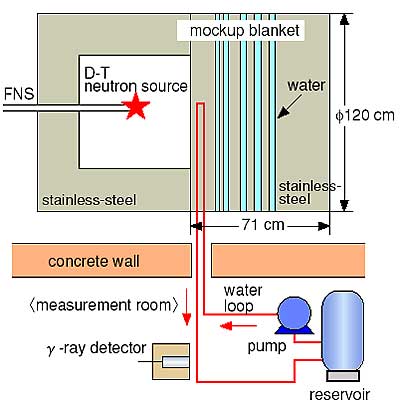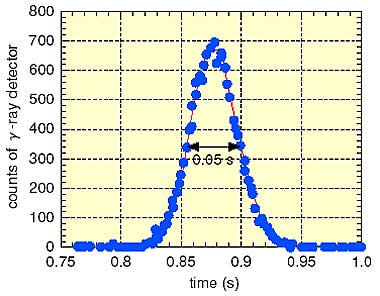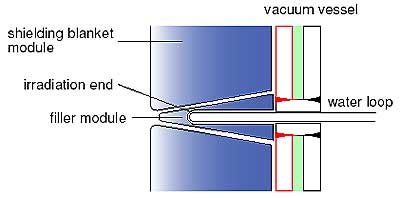When water is irradiated by 14MeV neutrons, radioactive 16N nuclei are produced by the 16O(n, p)16N reactions from oxygen atoms in water molecules. Because a 16N nucleus emits 6.13 and 7.12 MeV gamma-rays, we can measure the neutron yield continuously with a closed water loop installed in the blanket region of a fusion reactor. The activated water will stay in a reservoir tank for 2-3 minutes to diminish the activity and will be transferred to the blanket region again. The fusion power can be evaluated from the activity of water, because the neutron yield is proportional to the fusion power.
The experiment was carried out at the Fusion Neutronics Source facility (FNS)
as shown in Fig. 3-13. A water loop was inserted into the shielding blanket mock-up
to simulate a neutron field at the irradiation end, which is a part of the water
loop to be irradiated with the highest neutron flux, in the shielding blanket
region of ITER. The gamma-rays from 16N were measured at a location 10 m far from
the irradiation end. A BGO (Bi4Ge3O12) scintillation detector was used as the
gamma-ray detector, which had high detection efficiency for high energy gamma-rays.
The time resolution was evaluated from the time spread of the count rate of the
gamma-ray detector for pulsed neutrons with a pulse width of 10 ms. As shown in
Fig. 3-14, a time resolution of 0.05 s was obtained for a flow velocity of 10
m/s, which met the ITER requirement of 0.1 s or less. Also it was found that the
time resolution was explained by the turbulent diffusion of the water flow and
was proportional to the traveling time from the irradiation end to the gamma-ray
detector.
Based on those experimental results, a neutron monitor using water activation has been designed for ITER. As shown in Fig.
3-15, the irradiation end will be inserted into a filler module, which is a wedge shaped shield between shielding blanket modules, passing through the vacuum vessel. The gamma-ray counting stations will be installed in the pit. In this case, the distance between the irradiation end and the counting station will be ~20 m. With this arrangement, a time resolution was confirmed to be less than 0.1 s for a flow velocity of 10 m/s, taking account of the turbulent diffusion of the water flow. Finally, this neutron monitor using water activation was adopted in the ITER design as one of the neutron monitors. |


